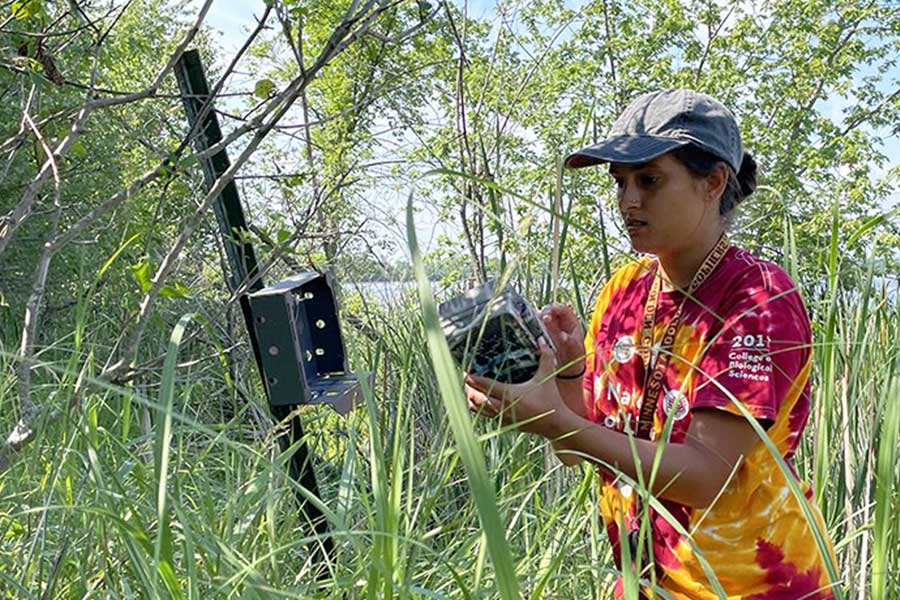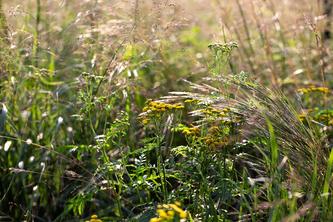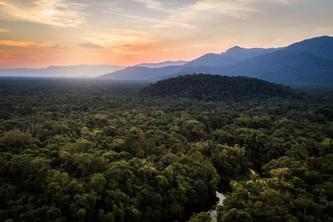
Maya Vellicolungara has a passion for pollinators. A current entomology graduate student at the University of Minnesota, she began her first field session with the Dan Cariveau Native Bee Lab on the Twin Cities campus in St. Paul this summer.
Vellicolungara’s research focuses on bumblebee and butterfly abundance and diversity on Conservation Reserve Program (CRP) lands. “CRP is a program that farmers can enroll in, where they set aside a portion of their land and install plants,” explains Vellicolungara.
She will visit CRP plantings that were established using either low- or high-cost seed mixes, comparing the pollinator communities on each. “This project is unique because it is a collaboration between three labs and we will be collecting data on grassland birds, plants, and pollinators,” she says. “The work I do is important because it aims to determine which CRP practices are most cost effective, which will help inform future CRP decision-making.”
Vellicolungara says she is looking forward to spending time outdoors in the untouched remnant prairies (prairies that have not been plowed or converted to agriculture). “A remnant prairie in full bloom is a super beautiful thing, and it isn’t something that many people get to see due to the limited amount of remnant prairies remaining,” she says.
Before working with the Bee Lab, Vellicolungara participated in a variety of undergraduate research. She worked at the U of M’s Animal Communication Laboratory as a directed researcher, studying frog species. Later she worked as an intern in the Isbell Biodiversity Lab, assisting researchers with data collection for many different projects.
Vellicolungara also had the opportunity to conduct an individual research project on the effects of agricultural field abandonment and burning on insect abundance. Most recently, she worked as a wildlife technician for Dakota County, monitoring surveys for different animals including marsh birds, bats, frogs/toads, turtles, small mammals, and bumblebees—and coordinating its public wildlife monitoring volunteer program.
As an undergraduate, Vellicolungara started off as a biology major before switching to a degree in ecology, evolution, and behavior. She found interest in ecology after being introduced to its “creative and less rigid” approach in her classes. She also volunteered at the UMN Insect Collection, which sparked more interest in insects.
In the future, Vellicolungara hopes to work for a government agency or nonprofit as an ecologist.
Vellicolungara believes that people should care about bees and pollinators not just for the ecosystem services that they can provide, but also for the ecological functions and intrinsic values that they hold. She explains that many species of bumblebees are in decline and their geographic ranges are contracting significantly due to many factors including pesticide use, climate change, and resource availability.
She also urges the public to learn more about their important role in supporting the preservation of pollinators. “...There are some programs such as CRP and Lawns to Legumes, which help people implement pollinator habitat on their land. Planting native flowering species in your backyard can provide vital resources for pollinators that are living in human-dominated landscapes.”
“I would like to see changes in the law that better protect bees and pollinators through limiting the application frequency and type of pesticides that are allowed,” she adds. “It would also be great if lawmakers made it a priority to increase the amount of prairie habitat, since agriculture has replaced prairie in the majority of Minnesota.
- Categories:
- Agriculture and Environment
- Environmental health
- Research





